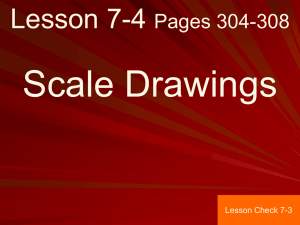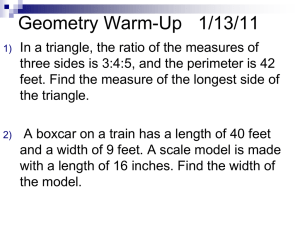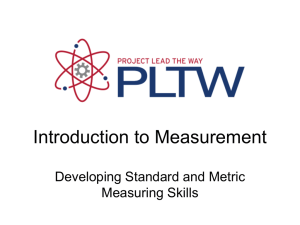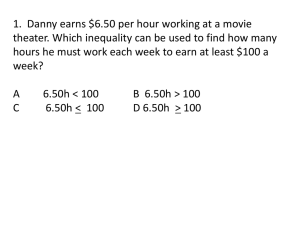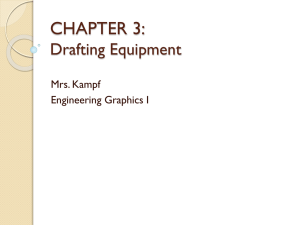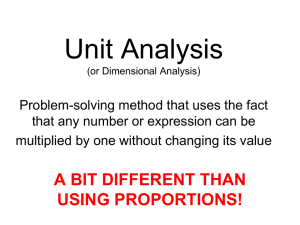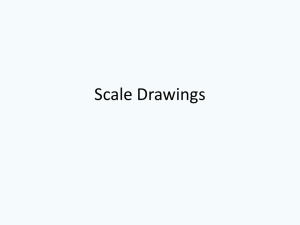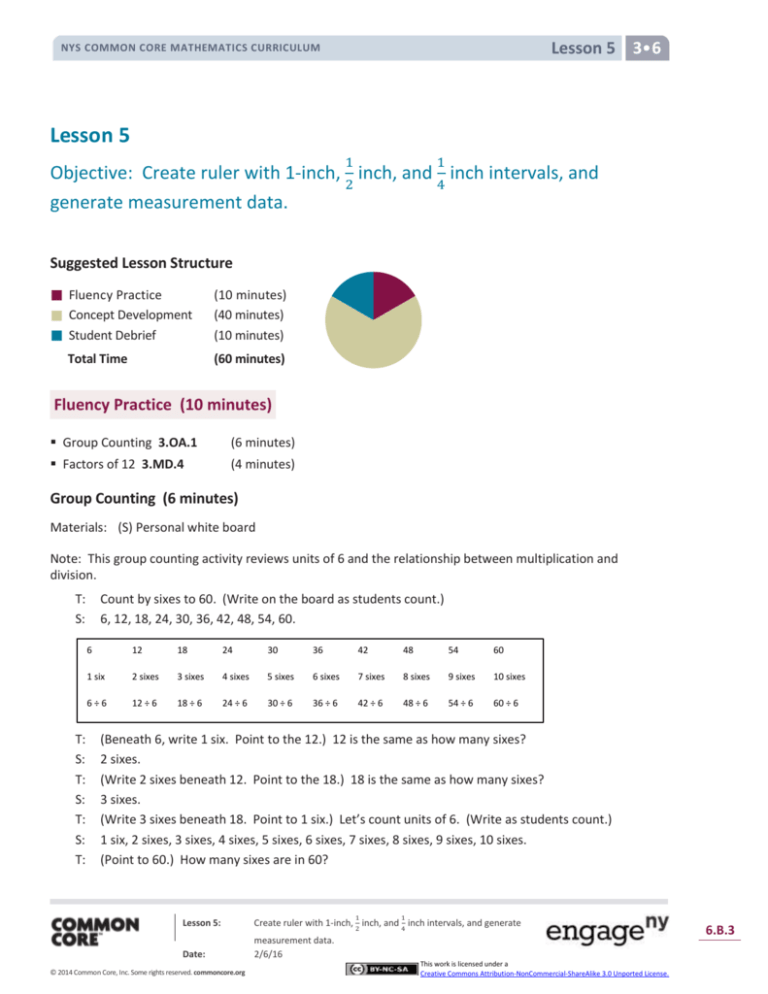
Lesson 5 3 6
NYS COMMON CORE MATHEMATICS CURRICULUM
Lesson 5
1
1
Objective: Create ruler with 1-inch, inch, and inch intervals, and
2
4
generate measurement data.
Suggested Lesson Structure
Fluency Practice
Concept Development
Student Debrief
Total Time
(10 minutes)
(40 minutes)
(10 minutes)
(60 minutes)
Fluency Practice (10 minutes)
Group Counting 3.OA.1
(6 minutes)
Factors of 12 3.MD.4
(4 minutes)
Group Counting (6 minutes)
Materials: (S) Personal white board
Note: This group counting activity reviews units of 6 and the relationship between multiplication and
division.
T:
S:
T:
S:
T:
S:
T:
S:
T:
Count by sixes to 60. (Write on the board as students count.)
6, 12, 18, 24, 30, 36, 42, 48, 54, 60.
6
12
18
24
30
36
42
48
54
60
1 six
2 sixes
3 sixes
4 sixes
5 sixes
6 sixes
7 sixes
8 sixes
9 sixes
10 sixes
6÷6
12 ÷ 6
18 ÷ 6
24 ÷ 6
30 ÷ 6
36 ÷ 6
42 ÷ 6
48 ÷ 6
54 ÷ 6
60 ÷ 6
(Beneath 6, write 1 six. Point to the 12.) 12 is the same as how many sixes?
2 sixes.
(Write 2 sixes beneath 12. Point to the 18.) 18 is the same as how many sixes?
3 sixes.
(Write 3 sixes beneath 18. Point to 1 six.) Let’s count units of 6. (Write as students count.)
1 six, 2 sixes, 3 sixes, 4 sixes, 5 sixes, 6 sixes, 7 sixes, 8 sixes, 9 sixes, 10 sixes.
(Point to 60.) How many sixes are in 60?
1
1
2
4
Lesson 5:
Create ruler with 1-inch, inch, and inch intervals, and generate
Date:
measurement data.
2/6/16
© 2014 Common Core, Inc. Some rights reserved. commoncore.org
This work is licensed under a
Creative Commons Attribution-NonCommercial-ShareAlike 3.0 Unported License.
6.B.3
Lesson 5 3 6
NYS COMMON CORE MATHEMATICS CURRICULUM
S:
T:
S:
T:
S:
10 sixes.
(Beneath 10 sixes, write 60 ÷ 6 =
.) What’s 60 ÷ 6?
10.
(Write 60 ÷ 6 = 10. Beneath 1 six, write 6 ÷ 6 =
.) On your personal white board, write the
number sentence.
(6 ÷ 6 = 1.)
Repeat the process for the rest of the chart.
Factors of 12 (4 minutes)
Note: This activity prepares students for today’s lesson.
T:
S:
(Write 12 ×
12 × 1 = 12.
= 12.) Say the number sentence, completing the unknown factor.
Continue with the following possible sequence: 1 ×
3×
= 12.
T:
S:
T:
S:
T:
S:
T:
S:
T:
S:
= 12, 6 ×
= 12, 4 ×
= 12, 2 ×
= 12, and
I’ll say a factor. You say the factor you need to multiply it by to get 12. The first factor is 1.
12.
6?
2.
4?
3.
12?
1.
3?
4.
Concept Development (40 minutes)
Materials: (S) 1" × 6" strip of yellow construction paper, colored pencils or markers (black, red, and blue),
1
1
ruler, lined paper (Template), 1 straw precut (vary 1", 2", and 4″ lengths among students),
Problem Set
Problem 1: Partition and measure a paper strip into a ruler with whole-inch, half-inch, and quarter-inch
measurements.
T:
MP.5
T:
(Give each student one copy of the lined paper Template.) Turn your paper so the margin is
horizontal. Draw a number line on top of the margin. Mark 0 on the point where I did. (Model.)
Use your black marker to plot a point at every 4 spaces. Use the paper’s vertical lines to measure
the 4 spaces. Then, label the number line from 0 to 6, making sure there are 4 spaces for each part.
Tell your partner how you know each part is equal.
1
1
2
4
Lesson 5:
Create ruler with 1-inch, inch, and inch intervals, and generate
Date:
measurement data.
2/6/16
© 2014 Common Core, Inc. Some rights reserved. commoncore.org
This work is licensed under a
Creative Commons Attribution-NonCommercial-ShareAlike 3.0 Unported License.
6.B.4
Lesson 5 3 6
NYS COMMON CORE MATHEMATICS CURRICULUM
S:
T:
T:
MP.5
T:
T:
S:
T:
S:
(Discuss.)
Use a ruler to trace the vertical lines up from your number line to the
top of the paper at each point. (Pass out 1 yellow strip to each student.)
Lay the yellow strip so that the left end touches the 0 endpoint on the
original number line, and the right end touches the vertical line that you
traced at the number 6 (as shown to the right).
Where the lines touch your strip, plot points on your strip. Extend the
points to make them tick marks. Then, turn your strip and number
below each tick mark from 0–6. (After labeling and turning the strip
back to its original position, the numbers on the strip will be upside
down and ordered opposite from those on the number line. This is
shown to the right.)
Use your ruler to verify that the intervals on your strip are equal.
Measure the full length of the yellow strip in inches. Measure the equal
parts.
What measurement does each mark represent?
1 inch.
We now know every 4 spaces marks 1 inch on our strip. Let’s repeat the
process, but this time we will mark a point on our number line (lined
paper) at every 2 spaces. What measurement will each mark represent?
Talk to a partner.
Two spaces is half. So, that must mean we will mark half inches!
Creating the Number Line
Measuring Inches
Measuring Half Inches
Repeat the process:
Plot points at every 2 spaces with a red marker to mark half inches. If a
point is already marked with a whole inch, plot the new, red point above
the black point. Then, plot and label every half inch between the whole
inches on the strip.
Plot points at every single interval with a blue marker to mark the
quarter inches. If a point is already marked with a whole or half inch,
plot the new, blue point above the black or red point. Then, plot every
quarter inch between the half inches on the strip. Do not have students
label every quarter inch on the strip since the spaces are too small.
Measuring Quarter Inches
Place the paper strip under a ruler to verify the accuracy of the paper
strip’s measurements. Encourage students to recognize that their paper
strips are, in fact, rulers as well.
T:
S:
T:
S:
Into what three units of measurement did we partition our
paper strips, or rulers?
Whole inches, half inches, and quarter inches.
Point to 2 inches on your paper ruler.
(Point.)
1
1
2
4
Lesson 5:
Create ruler with 1-inch, inch, and inch intervals, and generate
Date:
measurement data.
2/6/16
© 2014 Common Core, Inc. Some rights reserved. commoncore.org
This work is licensed under a
Creative Commons Attribution-NonCommercial-ShareAlike 3.0 Unported License.
6.B.5
Lesson 5 3 6
NYS COMMON CORE MATHEMATICS CURRICULUM
T:
S:
T:
Show your partner 1 half inch less than 2 inches on
your paper ruler.
(Show.)
What is 1 half inch less than 2 inches?
S:
1 2 inches.
T:
Show 3 4 inches.
S:
(Show.)
T:
Show your partner 1 and a quarter inch more than
1
3 inches.
S:
(Show.)
T:
What is 1 and a quarter inch more than 3 4 inches?
S:
1
42
NOTES ON
MULTIPLE MEANS
OF ACTION AND
EXPRESSION:
1
Scaffold student partitioning and
measuring of the paper strip with the
following options:
1
4
Instruct how to align the zero
points of the ruler and the strip
step-by-step.
Decrease the number of steps by
pre-numbering the number line or
pre-marking inches.
Use color. Highlight every fourth
line of the grid, or lightly shade
every other 4 lines.
Make the inch lines tactile with
glue or Wikki Stix to help students
with low vision or perceptual
difficulties. Because the surface of
the grid will be bumpy, have
students label numbers once the
strip is off the lined paper.
1
inches.
1
2
Continue the process as needed with inch less than 4 inches,
1
4
1
4
1
4
3
4
inch more than 1 inches, inch less than 2 inches, inch
3
more than 3 inches, and 4 inch less than 3 inches.
T:
S:
T:
S:
T:
S:
T:
S:
How many half inches are in 1 inch?
2 half inches.
How many quarter inches are in 1 inch?
4 quarter inches.
How many quarter inches are in 1 half inch?
2 quarter inches.
How many quarter inches are in 3 inches?
12 quarter inches.
Problem 2: Generate measurement data.
Pass out the Problem Set and 1 pre-cut straw to each student.
T:
S:
T:
On Problem 1 of your Problem Set, use your paper ruler to measure
your straw to the nearest inch, half inch, and quarter inch. What do
you do if your measurement is not exact?
We have to estimate.
When you estimate, ask yourself, “Is it more than halfway or less than halfway?” After measuring
the straw you have, measure six of your classmates’ straws and record their measurements in the
chart on your Problem Set.
Note: Students should save their rulers. They will also be used in Lessons 6─7.
1
1
2
4
Lesson 5:
Create ruler with 1-inch, inch, and inch intervals, and generate
Date:
measurement data.
2/6/16
© 2014 Common Core, Inc. Some rights reserved. commoncore.org
This work is licensed under a
Creative Commons Attribution-NonCommercial-ShareAlike 3.0 Unported License.
6.B.6
Lesson 5 3 6
NYS COMMON CORE MATHEMATICS CURRICULUM
Problem Set (10 minutes)
Students should do their personal best to complete the
remainder of the Problem Set within the allotted 10 minutes.
For some classes, it may be appropriate to modify the
assignment by specifying which problems they work on first.
Some problems do not specify a method for solving. Students
should solve these problems using the RDW approach used for
Application Problems.
Student Debrief (10 minutes)
Lesson Objective: Create ruler
1
4
1
with 1-inch,
2
NOTES ON
MULTIPLE MEANS
OF ACTION AND
EXPRESSION:
Support English language learners as
they write their responses on the
Problem Set. Allow students to discuss
their thoughts in their language of
choice before writing. Provide
sentence starters and a word bank.
Sentence starters may include the
following:
inch, and
inch intervals, and generate measurement data.
The Student Debrief is intended to invite reflection and active
processing of the total lesson experience.
One half inch is the same as_____.
It’s best to use the quarter-inch
ruler to measure because_____.
Possible words for the word bank may
include the following:
Invite students to review their solutions for the Problem
Set. They should check work by comparing answers with a
partner before going over answers as a class. Look for
misconceptions or misunderstandings that can be
addressed in the Debrief. Guide students in a conversation
to debrief the Problem Set and process the lesson.
exact
estimate
accurate
precise measure
Any combination of the questions below may be used to
lead the discussion.
Look at your data for Problem 1. Did you notice a
pattern?
Share your answer for Problem 1(c).
Have students share their thinking for Problem
2(c). If time permits, have a few students
measure an object larger than 6 inches with their
paper ruler using the method they describe.
Share your answer to Problem 3. What number
sentence could you use to find the answer?
How did using the lined paper help you partition
your paper strip accurately?
Each paper strip measured 6 inches, so our
measurements were easy to mark. What if the
strips were 8 inches instead? How would you
partition the number line?
1
1
2
4
Lesson 5:
Create ruler with 1-inch, inch, and inch intervals, and generate
Date:
measurement data.
2/6/16
© 2014 Common Core, Inc. Some rights reserved. commoncore.org
This work is licensed under a
Creative Commons Attribution-NonCommercial-ShareAlike 3.0 Unported License.
6.B.7
Lesson 5 3 6
NYS COMMON CORE MATHEMATICS CURRICULUM
Exit Ticket (3 minutes)
After the Student Debrief, instruct students to complete
the Exit Ticket. A review of their work will help with
assessing students’ understanding of the concepts that
were presented in today’s lesson and planning more
effectively for future lessons. The questions may be read
aloud to the students.
1
1
2
4
Lesson 5:
Create ruler with 1-inch, inch, and inch intervals, and generate
Date:
measurement data.
2/6/16
© 2014 Common Core, Inc. Some rights reserved. commoncore.org
This work is licensed under a
Creative Commons Attribution-NonCommercial-ShareAlike 3.0 Unported License.
6.B.8
Lesson 5 Problem Set 3 6
NYS COMMON CORE MATHEMATICS CURRICULUM
Name
Date
1
1
1. Use the ruler you made to measure different classmates’ straws to the nearest inch, 2 inch, and 4 inch.
Record the measurements in the chart below. Draw a star next to measurements that are exact.
Measured to the
𝟏
nearest 𝟐 inch
Measured to the
nearest inch
Straw Owner
Measured to the
𝟏
nearest 𝟒 inch
My straw
a. _______________ ’s straw is the shortest straw I measured. It measures _______ inch(es).
b. _______________ ’s straw is the longest straw I measured. It measures _______ inches.
1
c. Choose the straw from your chart that was most accurately measured with the 4 inch intervals on
1
your ruler. How do you know the 4 inch intervals are the most accurate for measuring this straw?
1
1
2
4
Lesson 5:
Create ruler with 1-inch, inch, and inch intervals, and generate
Date:
measurement data.
2/6/16
© 2014 Common Core, Inc. Some rights reserved. commoncore.org
This work is licensed under a
Creative Commons Attribution-NonCommercial-ShareAlike 3.0 Unported License.
6.B.9
Lesson 5 Problem Set 3 6
NYS COMMON CORE MATHEMATICS CURRICULUM
2. Jenna marks a 5-inch paper strip into equal parts as shown below.
a. Label the whole and half inches on the paper strip.
1
b. Estimate to draw the 4 inch marks on the paper strip. Then, fill in the blanks below.
1 inch is equal to _______ half inches.
1 inch is equal to _______ quarter inches.
1 half inch is equal to _______ quarter inches.
c. Describe how Jenna could use this paper strip to measure an object that is longer than 5 inches.
3. Sari says her pencil measures 8 half inches. Bart disagrees and says it measures 4 inches. Explain to Bart
why the two measurements are the same in the space below. Use words, pictures, or numbers.
1
1
2
4
Lesson 5:
Create ruler with 1-inch, inch, and inch intervals, and generate
Date:
measurement data.
2/6/16
© 2014 Common Core, Inc. Some rights reserved. commoncore.org
This work is licensed under a
Creative Commons Attribution-NonCommercial-ShareAlike 3.0 Unported License.
6.B.10
Lesson 5 Exit Ticket 3 6
NYS COMMON CORE MATHEMATICS CURRICULUM
Name
Date
Davon marks a 4-inch paper strip into equal parts as shown below.
a. Label the whole and quarter inches on the paper strip.
b. Davon tells his teacher that his paper strip measures 4 inches. Sandra says it measures 16 quarter
inches. Explain how the two measurements are the same. Use words, pictures, or numbers.
1
1
2
4
Lesson 5:
Create ruler with 1-inch, inch, and inch intervals, and generate
Date:
measurement data.
2/6/16
© 2014 Common Core, Inc. Some rights reserved. commoncore.org
This work is licensed under a
Creative Commons Attribution-NonCommercial-ShareAlike 3.0 Unported License.
6.B.11
Lesson 5 Homework 3 6
NYS COMMON CORE MATHEMATICS CURRICULUM
Name
Date
1
1
1. Travis measured 5 different-colored pencils to the nearest inch, 2 inch, and 4 inch. He records the
measurements in the chart below. He draws a star next to measurements that are exact.
Colored
Pencil
Measured to the
nearest inch
Measured to the
𝟏
nearest 𝟐 inch
Red
7
6
Blue
5
5
Yellow
6
5
Purple
5
4
Green
2
3
1
Measured to the
𝟏
nearest 𝟒 inch
6
2
5
1
2
5
1
4
2
1
3
4
1
4
1
2
3
4
3
4
a. Which colored pencil is the longest? _______________________________
It measures ________ inches.
b. Look carefully at Travis’s data. Which colored pencil most likely needs to be measured again? Explain
how you know.
1
1
2
4
Lesson 5:
Create ruler with 1-inch, inch, and inch intervals, and generate
Date:
measurement data.
2/6/16
© 2014 Common Core, Inc. Some rights reserved. commoncore.org
This work is licensed under a
Creative Commons Attribution-NonCommercial-ShareAlike 3.0 Unported License.
6.B.12
Lesson 5 Homework 3 6
NYS COMMON CORE MATHEMATICS CURRICULUM
2. Evelyn marks a 4-inch paper strip into equal parts as shown below.
a. Label the whole and half inches on the paper strip.
1
b. Estimate to draw the 4 inch marks on the paper strip. Then, fill in the blanks below.
1 inch is equal to _______ half inches.
1 inch is equal to _______ quarter inches.
1 half inch is equal to _______ quarter inches.
2 quarter inches are equal to _______ half inch.
1
3. Travis says his yellow pencil measures 5 2 inches. Ralph says that’s the same as 11 half inches. Explain
how they are both correct.
1
1
2
4
Lesson 5:
Create ruler with 1-inch, inch, and inch intervals, and generate
Date:
measurement data.
2/6/16
© 2014 Common Core, Inc. Some rights reserved. commoncore.org
This work is licensed under a
Creative Commons Attribution-NonCommercial-ShareAlike 3.0 Unported License.
6.B.13
Lesson 5 Template
NYS COMMON CORE MATHEMATICS CURRICULUM
3•6
lined paper
Lesson 5:
Date:
© 2014 Common Core, Inc. Some rights reserved. commoncore.org
1
1
Create ruler with 1-inch, inch, and inch intervals, and generate measurement data.
2
4
2/6/16
This work is licensed under a Creative Commons Attribution-NonCommercial-ShareAlike 3.0 Unported License.
6.B.14



